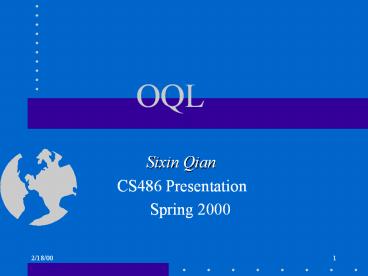OQL - PowerPoint PPT Presentation
1 / 28
Title: OQL
1
OQL
- Sixin Qian
- CS486 Presentation
- Spring 2000
2
An Overview of OQL
- OQL is an object database query language, and is
specified as part of the ODMG standards. - OQL is being used as an embedded query language.
- OQL can also be used as a stand-along query
language.
3
An Overview of OQL(II)
- OQL is based on SQL. Many queries in SQL are also
valid in OQL. - OQL also extends SQL to deal with object-oriented
notion.
4
OQL Types
- Basic types strings, ints, reals, etc., plus
class names. - Type constructors Struct for structures.
Collection types set, bag, list, array.
5
Schema-Definition Portion
- For every class we can declare an extent name
for the current set of objects of the class - ltltRemember to refer to the extent, not
- the class name, in queries.
6
Example
- interface Bar
- (extent Bars)
- attribute string name
- attribute string addr
- relationship SetltSellgt beersSold
- inverse Sellbar
7
Example (II)
- interface Beer
- (extent Beers)
- attribute string name
- attribute string manf
- relationship SetltSellgt SoldBy
- inverse Sellbeer
8
Example (III)
- interface Sell
- (extent Sells)
- attribute float price
- relationship Bar bar
- inverse BarbeersSold
- relationship Beer beer
- inverse BeersoldBy
9
Path Expressions
- Let x be an object of class C.
- If a is an attribute of C, then x.a the value
of a in the x object. - If r is a relationship of C, then x.r the value
to which x is connected by r. - ltltCould be an object or a collection of
- objects, depending on the type of r.
- If m is a method of C, then x.m () is the
result of applying m to x.
10
Examples
- Let s be a variable whose type is Sell.
- s.price the price in the object s.
- s.bar.addr the address of the bar mentioned in
s. - Note cascade of dots OK because s.bar is
an object, not a collection.
11
Example of Illegal Use of Dot
- b.beersSold.price, where b is a Bar object.
- Why illegal? Because b.beersSold is a set of
objects, not a single object.
12
OQL Select-From-Where
- SELECT ltlist of valuesgt
- FROM ltlist of collections and typical
- membersgt
- WHERE ltconditiongt
13
OQL Select-From-Where (II)
- Collections in FROM can be
- 1. Extents.
- 2. Expressions that evaluate to a
- collection.
- Following a collection is a name for a typical
member.
14
Example
- Get the menu at Joes.
- SELECT s.beer.name, s.price
- FROM Sells s
- WHERE s.bar.name Joes Bar
- Notice double-quoted strings in OQL.
- Result is of type
- Bag ( Struct (name string, price float) )
15
Example
- Another way to get Joes menu, this time focusing
on the Bar objects. - SELECT s.beer.name, s.price
- FROM Bars b, b.beersSold s
- WHERE b.name Joes Bar
16
Example (cont)
- Notice that the typical object b in the first
collection of FROM is used to help define the
second collection. - Typical usage if x.a is an object,you can
extend the path expression if x.a is a
collection, you use it in the FROM list.
17
Tailoring the type of the Result
- Default bag of structs, field names taken from
the ends of pathnames in SELECT clause. - Example
- SELECT s.beer.name, s.price
- FROM Bars b, b.beersSold s
- WHERE b.name Joes Bar
- has result type
- Bag ( Struct(name string, price float) )
18
Rename Fields
- Prefix the path with the desired name and a
colon. - Example
- SELECT beer s.beer.name, s.price
- FROM Bars b, b.beersSold s
- WHERE b.name Joes Bar
19
Change the Collection Type
- Use SELECT DISTINT to get a set of structs.
20
Example
- SELECT DISTINT s.beer.name, s.price
- FROM Bars b, b.beersSold s
- WHERE b.name Joes Bar
- Use ORDER BY clause to get a list of structs.
21
Example
- joeMenu
- SELECT s.beer.name, s.price
- FROM Bars b, b.beersSold s
- WHERE b.name Joes Bar
- ORDER BY s.price ASC
- ASC ascending (default) DESC descending.
- We can extract from a list as if it were an
array, e.g. cheapest joeMenu1.name
22
Subqueries
- Used mainly in FROM clauses and with quantifiers
EXISTS and FORALL.
23
Example Subquery in FROM
- Find the manufacturers of the beers served at
Joes - SELECT b.manf
- FROM (
- SELECT s.beer
- FROM Sells s
- WHERE s.bar.name Joes Bar
- ) b
24
Quantifiers
- Boolean-valued expressions for use in
WHERE-clauses. - FOR ALL x IN ltcollectiongt
- ltconditiongt
- The expression has value TRUE if the condition is
true for all (resp. at least one in EXISTS)
elements of the collection.
25
Example
- Find all bars that sell some beer for more than
5. - SELECT b.name
- FROM Bars b
- WHERE EXISTS s IN b.beersSold
- s.price gt 5.00
- How would you find the bars that only sold beers
for more than 5?
26
Example
- Find the bars such that the only beers they sell
for more than 5 are manufactured by Petes. - SELECT b.name
- FROM Bars b
- WHERE FOR ALL be IN (
- SELECT s.beer
- FROM b.beersSold s
- WHERE s.price gt 5.00
- ) be.manf Petes
27
Extraction of Collection Elements Example
- Print Joes menu, in order of price, with beers
of the same price listed alphabetically.
28
Example (II)
- L SELECT s.beer.name, s.price
- FROM Sells s
- WHERE s.bar.name Joes Bar
- ORDER BY s.beer.name
- printf(Beer\tPrice\n\n)
- for(i1 iltCOUNT(L) i)
- printf(s\tf\n, Li.name, Li.price)































